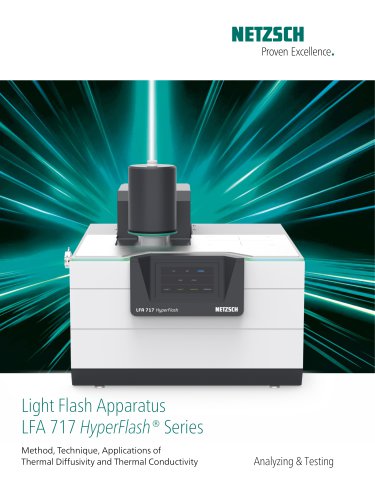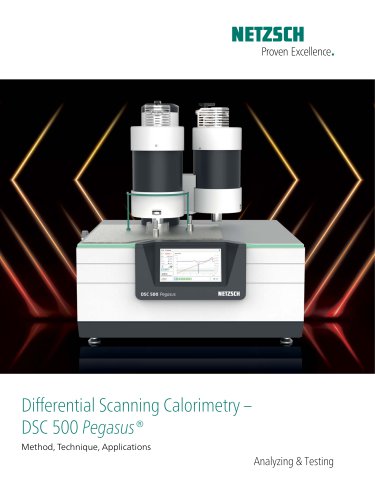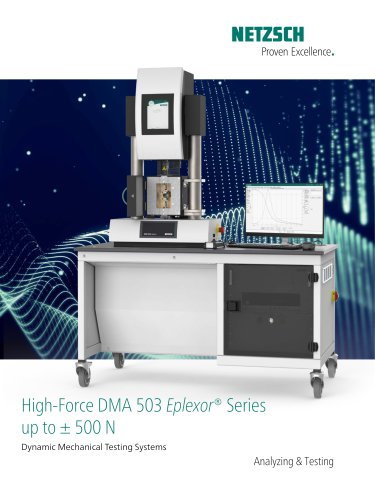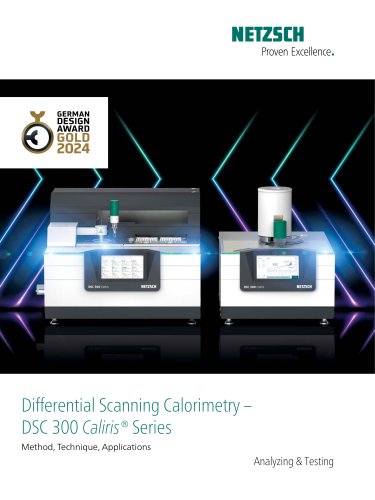 Website:
NETZSCH Analyzing & Testing
Website:
NETZSCH Analyzing & Testing
Group: NETZSCH
Catalog excerpts
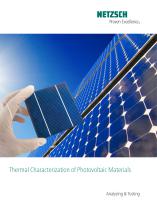
Thermal Characterization of Photovoltaic Materials Analyzing & Testing
Open the catalog to page 1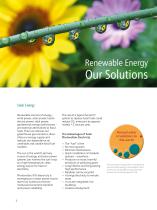
Renewable Energy Solar Energy Renewable sources of energy – wind power, solar power, hydroelectric power, tidal power, geothermal energy and biomass – are essential alternatives to fossil fuels. Their use reduces our greenhouse gas emissions, diversifies our energy supply and reduces our dependence on unreliable and volatile fossil fuel markets. The sun is the world’s primary source of energy, and solar power systems can harness the sun’s rays as a high-temperature, clean energy source for heat or electricity. Photovoltaic (PV) electricity is emerging as a major power source due to its...
Open the catalog to page 2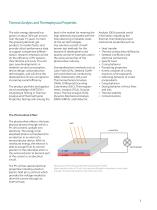
The solar energy demand has grown at about 30% per annum over the past 15 years. To meet the growing demand, get products to market faster, and provide critical performance data to support competitive differentiation, research emphasis will be on the efficiency of PV systems, their lifetime and costs. This will spur new developments in material use and consumption, device design, and production technologies, and will drive the development of new concepts for increasing overall efficiency. The product portfolio and applications knowledge of NETZSCH Analyzing & Testing in Thermal Analysis and...
Open the catalog to page 3
Differential Scanning Calorimetry Differential Scanning Calorimetry (DSC) is one of the most frequently employed thermal analysis methods. It can be used to analyze nearly any energetic effect occurring in a solid or liquid during thermal treatment. DSC analysis provides valuable information for the research and quality control of solar cells, including: ■ Analysis of amorphous encapsulants ■ nformation about process temperatures ■ Specific heat for determination of the thermal diffusivity/ conductivity ■ Kinetic analysis of the curing behavior The DSC 300 Caliris® Select/Supreme variants...
Open the catalog to page 4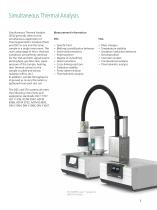
Simultaneous Thermal Analysis (STA) generally refers to the simultaneous application of Thermogravimetric Analysis (TGA) and DSC to one and the same sample in a single instrument. The main advantage of this is that test conditions are perfectly identical for the TGA and DSC signals (same atmosphere, gas flow rate, vapor pressure of the sample, heating rate, thermal contact to the sample crucible and sensor, radiation effect, etc.). In addition, sample throughput is improved as more information is gathered from each test run. The DSC and STA systems all meet the following instrument and...
Open the catalog to page 5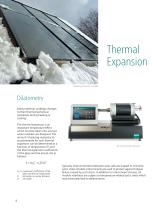
Thermal Expansion Stressing of the PV module Dilatometry Many materials undergo changes to their thermomechanical properties during heating or cooling. The thermal expansion is an important temperature effect which must be taken into account when modules are designed. The amount of spacing necessary to accommodate for such thermal expansion can be determined as a function of temperature (T) and the thermal expansion coefficients of the glass and the actual cell, as follows: δ = (αGC - αCD) ΔT αG, αC: expansion coefficients of the glass and the cell respectively C: cell center-to-center...
Open the catalog to page 6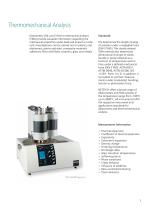
Thermomechanical Analysis Dilatometry (DIL) and Thermo-mechanical Analysis (TMA) provide valuable information regarding the mechanical properties under load and impact on solar cells. Investigations can be carried out on plastics and elastomers, paints and dyes, composite materials, adhesives, films and fibers, ceramics, glass and metals. Standards DIL determines the length change of samples under a negligible load (DIN 51045). The closely related TMA method also determines dimensional changes to solids, liquids or pasty materials as a function of temperature and/or time under a defined...
Open the catalog to page 7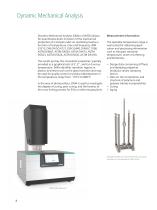
Dynamic Mechanical Analysis Dynamic Mechanical Analysis (DMA or DMTA) allows for quantitative deter-mination of the mechanical properties of a sample under an oscillating load as a function of temperature, time and frequency (DIN 53513, DIN EN ISO 6721, DIN 53440, DIN-IEC 1006, ASTM D4065, ASTM D4092, ASTM D4473, ASTM D5023, ASTM D5024, ASTM D5026, ASTM D5418). Measurement Information The results portray the viscoelastic properties, typically provided as a graphical plot of E’, E’’, and tan δ versus temperature. DMA identifies transition regions in plastics and resins such as the glass...
Open the catalog to page 8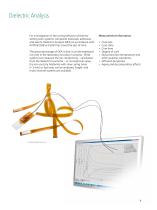
Measurement Information ■ Cure state Cure time ■ Glass transition temperature and other polymer transitions Diffusion properties ■ Aging and decomposition effects For investigation of the curing behavior of thermosetting resin systems, composite materials, adhesives and paints, Dielectric Analysis (DEA) in accordance with ASTM E2038 or E2039 has stood the test of time. The great advantage of DEA is that it can be employed not only in the laboratory, but also in process. These systems can measure the ion conductivity - calculated from the dielectric loss factor - or its reciprocal value, the...
Open the catalog to page 9
The Advanced Software Module Today, many different polymers are appearing on the market which might be considered for the PV lamination process. However, their thermal behavior is critical for such applications and must be investigated before decisions can be made. For lamination, the time- and temperature-dependent curing reactions (e.g., of EVA copolymer films) play an especially important role. Fluctuations in the curing agent may occur and therefore require special attention. The NETZSCH Advanced Software module Thermokinetics is capable of creating kinetic models of any chemical...
Open the catalog to page 10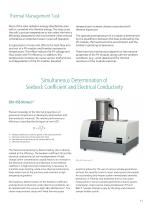
An analysis in Thermokinetics allows for the determination of the number of reaction steps, and for each step, the following values: Reaction type ■ Other kinetic parameters The software allows for the analysis of heterogeneous reactions, including phase-boundary reactions, reactions with diffusion and nucleation, and reactions with partial diffusion control. Various methods of kinetic analysis and predictions are integrated into the program: ■ Model-free kinetic analysis (Friedman, Ozawa-Flynn-Wall, and ASTM E698) ■ Model-fit using multivariate nonlinear regression (model definition,...
Open the catalog to page 11All NETZSCH Analyzing & Testing catalogs and technical brochures
-
LFA 427 - product brochure
24 Pages
-
Kinexus Prime Series
20 Pages
-
Kinexus Prime DSR Series
20 Pages
-
LFA 717 HyperFlash® Series
28 Pages
-
Product Overview
12 Pages
-
DMA 303 Eplexor
24 Pages
-
DSC 300 Caliris Series
28 Pages
-
STA 509 Jupiter Series
28 Pages
-
TG 309 Libra Series
24 Pages
-
DEA 288 Ionic
20 Pages
-
STA 2500 Regulus
12 Pages
-
NTA Guarded Hot Plate Series
16 Pages
-
TMA 402 F1/F3 Hyperion®
16 Pages
-
Rosand Series
20 Pages
-
Accelerating Rate Calorimetry
20 Pages
-
NTA HotBoxes
16 Pages
-
DIL 402 Expedis Select/Supreme
28 Pages
-
DIL 402 Expedis Classic
16 Pages
-
NETZSCH Energy Solutions
40 Pages
-
Advanced Materials Testing
32 Pages
-
NTA Fire Testing Systems
20 Pages
-
Kinetics NEO
20 Pages
-
TG-FTIR - product brochure
24 Pages
-
TA-QMS Coupling
28 Pages
-
HMOR 422
1 Pages
-
RUL/CIC 421
1 Pages
-
Cone Calorimeter TCC 918
12 Pages
-
Thermal Insulation Materials
24 Pages
-
SBA 458 Nemesis®
24 Pages
-
NETZSCH NEVIO Instrument Series
24 Pages
-
DMA GABO EPLEXOR up to 1500°C
12 Pages
-
GABOMETER®
8 Pages






